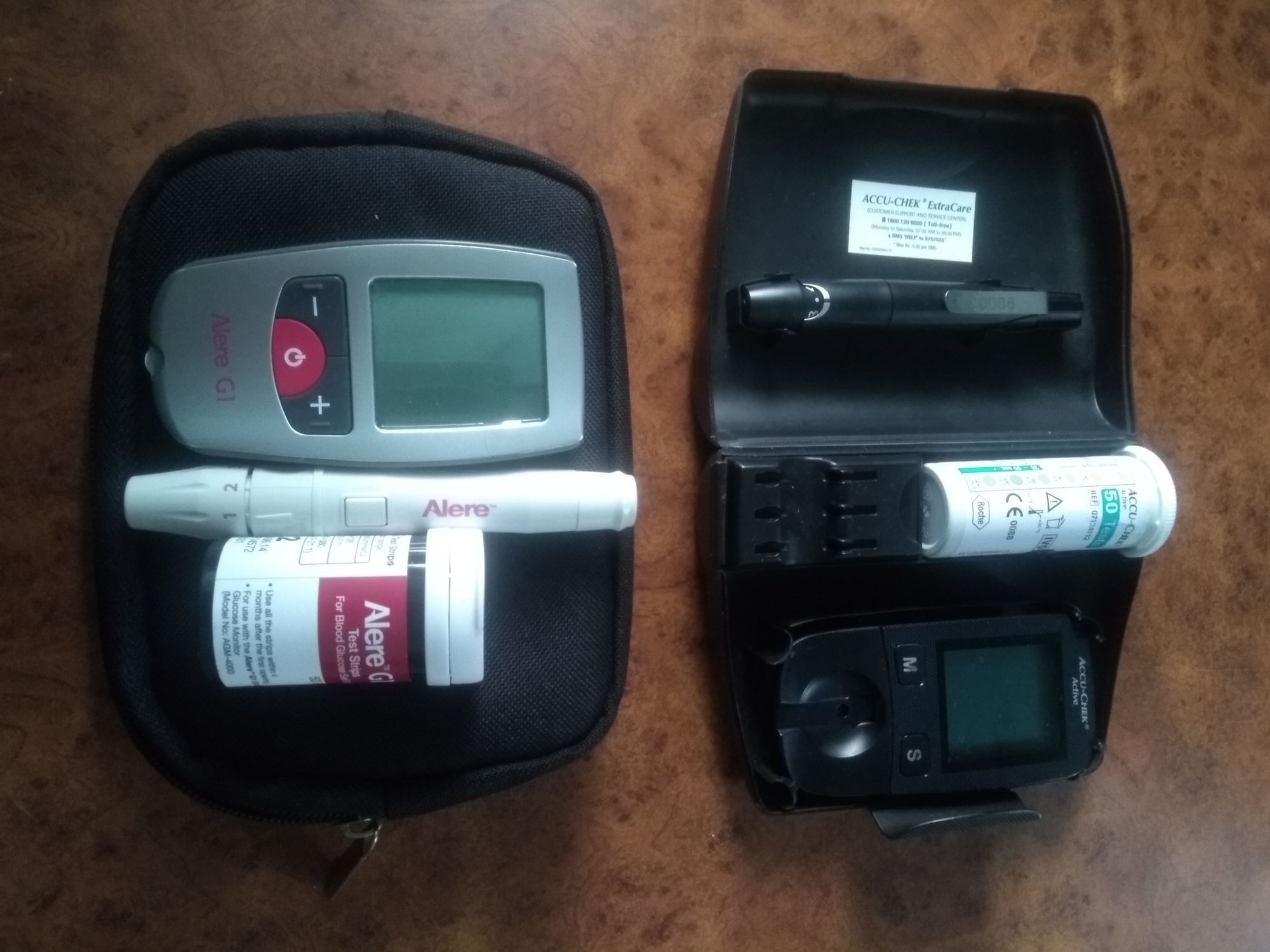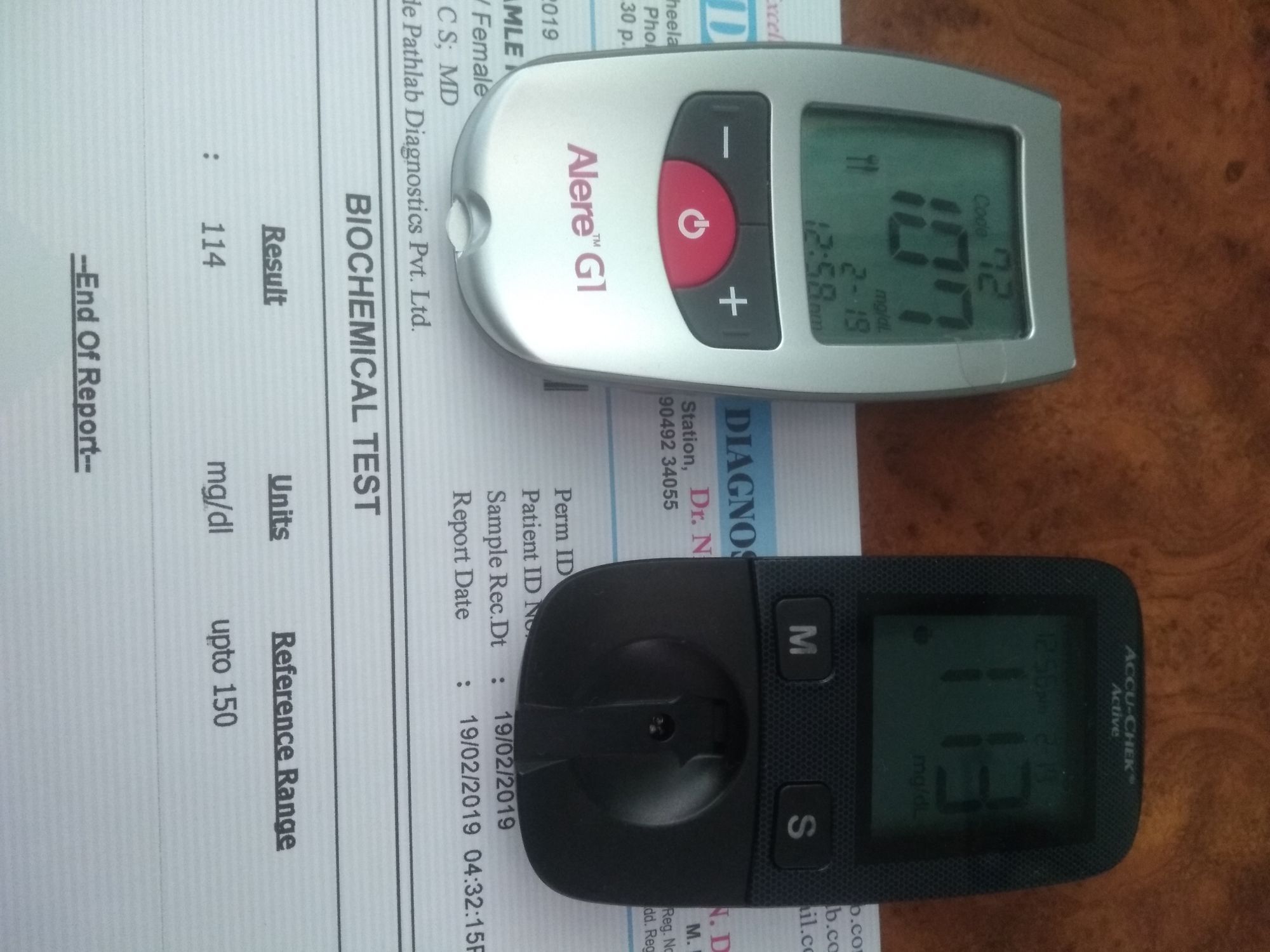Glucose Testing at Home: Accu Chek Active Glucose meter Vs Alere G1 Glucose meter
Sure, a smile is the best accessory one can wear. But as a Type 1 diabetic, we need to carry a few more accessories with us everywhere to mimic our pancreas.
For T1s, insulin shots (multiple daily injections via syringes or insulin pens) along with a glucose testing device make up for the most basic and affordable version of the artificial pancreas. This system works best if you keep a log of your BG levels, food, and other activities throughout the day and become a pro in carbohydrate counting.
After my diagnosis, I was told to buy a glucose meter and keep a log of my fasting and postprandial BGs only. When my father went to the nearest drugstore to buy a glucose meter (also known as a glucometer) for me, they insisted that he should purchase their in-house glucometer to avail the discount that they had to offer. It seemed to be a lucrative deal; thus it made my father buy that glucometer. But to our disappointment, the vial of 25 test strips did not even last for a week. And on top of that, those strips were available only at that drugstore. I then turned to Accu Chek Active glucometer as it was the pioneer glucometer in the Indian pharmaceutical market (who all remember that ad from the 2000s featuring Wasim Akram and the Roche’s Accu Chek glucometer?)
As the days passed by, I needed to check my BG more frequently as I was experiencing severe hypoglycemic episodes very often due to insulin overdose. Then I was introduced to Abbott's Freestyle Libre Pro, a Flash Glucose Monitoring System which changed my perspective towards diabetes management. A 14 days sensor of the Libre Pro did cost me INR 2000 which was close to my monthly expenditure on the test strips. But it provided remarkable statistics of my glycemic data which helped me to adjust my insulin doses. I used the Glimp app to scan my sensor as I didn’t have its reader. It needed a glucometer calibration once in a while, thus making the system slightly more expensive. Finally, I turned to my diabetes educator seeking a quality glucometer at a reasonable price and welcomed (now Abbott’s) Alere G1 glucometer as the third kit to my diabetes supplies collection.

Discussing the technical specifications of the Roche’s Accu Chek Active and Abbott’s Alere G1 glucometers:
The manual of each glucometer provides detailed information about the product. But having ample experience in buying a variety of glucometers gives me the privilege to discuss their salient features, pros, and cons.
- Test Result Range: The High and Low test results are displayed as HI and Lo respectively on each of the meters. The Accu Chek can display the test results as low below 10 mg/dL (0.6 mmol/L) and as high above 600 mg/dL (33.3 mmol/L). While the Alere G1 can display the test results between 20 and 600 mg/dL (1.1~33.3 mmol/L) as numbers and any value below or above as Lo and HI.
- Speed: The Accu Chek Active displays the test results in 5 seconds when the blood is applied on the test strip after inserting it into the slot and in about 8 seconds if the blood is applied on the strip before inserting it into the slot. In case of Alere G1, the blood has to be applied to the test strip only after inserting it into the slot.
- Accuracy: Both of these meters showed a difference of ±15 mg/dL when compared with the lab report. The control solution test performed to determine the reliability of the meters showed the results within the range printed on the vials of the respective test strips.
- Connectivity: The Accu Chek Active meter can be connected to PC via a Micro B USB cable. The glycemic data stored in it can be uploaded on the web portal of Accu Check (contact their customer service to know more about this feature). The uploaded data can also be shared with the healthcare professionals. Unfortunately, the Alere G1 does not have a web portal to upload the data.
- Alarms: The Accu Chek meter provides the facility to set an alarm to test BG after eating a meal i.e. after 2 hours. You need to make sure to mark before meal BG with an alarm symbol. On the other hand, 4 alarms of one’s individual preference can be set on the Alere G1 glucometer.
- Memory: Both of the meters are able to store 500 records with date, time and event of BG in the First-In-First-Out order. They also provide 7, 14, 30 and 90 days average.
- Power: Both of the meters run on a standard 3-volt CR2032 lithium battery that lasts for approximately 1000 results. Note that setting an alarm consumes more power. The Automatic power-off time for the Accu Chek meter is about 90 seconds while the Alere G1 takes 5 minutes.
- Sample volume: The Accu Chek glucometer requires 1-2 microlitre of fresh capillary blood while the Alere G1 glucometer requires comparatively less amount of blood i.e. 0.5 microlitre. (1 microlitre = 1 thousandth of a millilitre)
- Temperature: The Accu Chek Active meter can effectively work within 8 to 42°C while the Alere G1 can work within 1 to 32°C.
- Altitude: The Accu Chek can operate 4000m above the sea level while the Alere G1 can operate at the altitude upto 2500m.

Pros and Cons:
- Availability: The Accu Chek Active has captured about 70% of the Indian pharmaceutical market as it was the first glucometer launched in India. It can be found at almost every drugstore even in the remote areas of the country and on E-commerce websites as well. The test strips are also available at the drugstores and websites at competitive price. The Alere G1 has a poorer market capture in comparison. But it’s test strips are available on popular e-commerce websites like Amazon and Flipkart.
- Cost: The prices may vary from place to place. The Accu Chek Active meter along with 10 test strips can cost as low as INR 1300. A box of 100 test strips of the Accu Chek can cost as low as INR 1200 i.e. INR 12/test strip. On the other hand, the Alere G1 with 25 test strips costs around INR 1100. A box of 100 test strips of the Alere G1 costs around INR 800 i.e. INR 8/test strip.
My Verdict:
Alere G1 at Home and Accu Chek for Travel!
I prefer using the Accu Chek Active glucometer while traveling because if at all I run out of the test strips, I know they will be available at any drugstore. But for day-to-day testing at home, I tend to use Alere G1 glucometer it is quite affordable and gives accurate results as well. While it does not provide the facility to upload the glycemic data online, we can always use BG logging apps such as mySugr to get more insights. In the end, it’s all about interpreting the effect of your food intake, exercise etc on your BG, and avoid short and long term complications beforehand.
Because more tests, more corrections! More improvement in hbA1c, fewer complications!
SUPPORT BLUE CIRCLE DIABETES FOUNDATION
We need your help and support to continue to grow, expand and touch the lives of countless people in the diabetes community. Every little bit helps us in sustaining this endeavour.
Click here to donate

